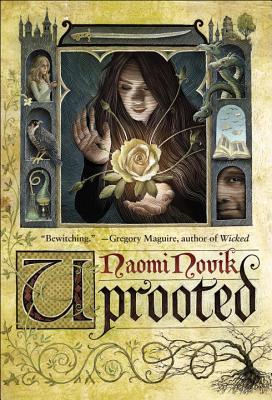Amazon Editors’ Science Fiction and Fantasy Pick of 2015
Hugo Award Nominee for Best Novel, 2016
Nebula Award Nominee for Best Novel, 2016
In this coming of age fantasy fairy tale, Agnieszka (“ag-NYESH-kah”), grows up in a village in a valley near the evil Wood, and because she loves the outdoors, is always covered in mud and brambles. A wizard called the Dragon (really a human—that’s just a cool name) protects the valley from the Wood, and in exchange, every ten years he takes a 17-year-old girl from the area to live in his tower. For years, the townspeople expected the beautiful talented Kasia, Agnieszka’s best friend, to be selected, but instead the Dragon takes Agnieszka.
Several early-formed expectations of mine were thankfully limited in scope, resulting in an enjoyable read. First, the story presents itself initially as a slow and meditative journey of Agnieszka’s transition from her rural family life to the study of magic under a strict and abusive teacher. Soon, however, the scope expands, and with a brisk pace, packs a surprising amount of plot and three separate story lines into this one volume. Mostly, the book follows Agnieszka as she cultivates her knowledge about her own magic, the wider world of her kingdom, and the subtle, corrupt, relentless threat of the Wood, which she will inevitably face.
Second, while Agnieszka’s magic is stong, her way of magic defies the traditional formalized academic spells the Dragon attempts to impose. Thankfully, the differences in magic are not overly related to gender, and Agnieszka’s gifts appear to be quite rare. As Agnieszka and the Dragon recognize their dissimilarities, the resulting teaching lessons are of some of my favorite moments, full of overt frustration, until they realize the effectiveness of weaving their spells together. However, Agnieszka’s refusal to work at magic for which she’s not inherently gifted reinforces a perception that hard work and study aren’t for everyone, which eventually leads to a distrust of science and technology in our modern world—not necessarily a lesson I’d like to see in a contemporary fairy tale.
There should be more strong friendships between women in books and media, and while I enjoy Agnieszka’s relationship with Kasia in theory, I don’t really care about Kasia and do not understand why Agnieszka spends a large portion of the book breaking all kinds of rules to save her. Contrasted with the always sweet Kasia, Agnieszka’s romance with the Dragon is incomprehensible because of his constant irritation with her and the verbal (and occasional physical) abuse he directs at her. Why do we teach young girls to accept abusive behavior?
In the same way that Neil Gaiman blends the real and the magical with mythology, Novik is able to use fairy tale and folklore to create a story that feels grounded and more substantial because of it’s traditions and underlying truths. It’s emotionally satisfying despite several faults. Recommended for fans of classic fairy tales, whose imagination is sparked by grumpy wizards, wicked woods, stubborn princes, captured queens, magical swords, and potions of unending fire.
“Those the walkers carried into the Wood were less lucky. We didn’t know what happened to them, but they came back out sometimes, corrupted in the worst way: smiling and cheerful, unharmed. They seemed almost themselves to anyone who didn’t know them well, and you might spend half a day talking with one of them and never realize anything was wrong, until you found yourself taking up a knife and cutting off your own hand, putting out your own eyes, your own tongue, while they kept talking all the while, smiling, horrible. And then they would take the knife and go inside your house, to your children, while you lay outside blind and choking and helpless even to scream. If someone we loved was taken by the walkers, the only thing we knew to hope for them was death, and it could only be a hope.”
